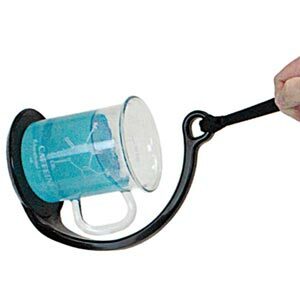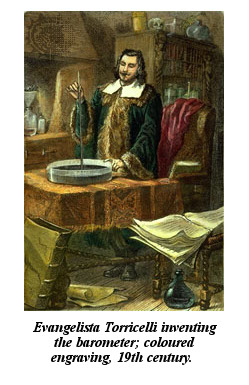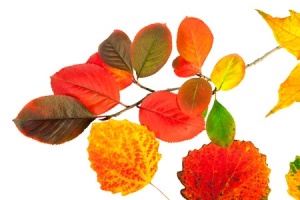February 9, 2015
 by: Evan Jones
by: Evan Jones
How the SpillNot works:
When you hold a cup of juice while walking, the juice tends to spill because the cup accelerates forward (ax, FIG.1, green arrow) and backward (-ax) with each step. The juice tips in response to that acceleration, and may spill over the rim of the cup.
 The Spill Not automatically tips the cup so that its top stays parallel to the juice surface (FIG.2). For example, if the juice surface tips to 30 deg, but the cup stays horizontal, the juice could spill. But if the cup also tips to 30 deg, we get no spill! Note that there are only 2 forces on each portion m of juice…the weight mg down, and the buoyancy force Fb of the juice pushing at a right angle to the surface. These two forces result in a horizontal accelerating force ma (in red). We see from FIG.1 that
The Spill Not automatically tips the cup so that its top stays parallel to the juice surface (FIG.2). For example, if the juice surface tips to 30 deg, but the cup stays horizontal, the juice could spill. But if the cup also tips to 30 deg, we get no spill! Note that there are only 2 forces on each portion m of juice…the weight mg down, and the buoyancy force Fb of the juice pushing at a right angle to the surface. These two forces result in a horizontal accelerating force ma (in red). We see from FIG.1 that
Read the rest of this entry »
 2 Comments |
2 Comments |  College level, experiments, High School level, Physics | Tagged: acceleration, centripetal force, hands-on activity, homeschool, parent friendly, PBL, pendulum, phenomenon based learning, phenomenon-based science, Physics, science, Spill not |
College level, experiments, High School level, Physics | Tagged: acceleration, centripetal force, hands-on activity, homeschool, parent friendly, PBL, pendulum, phenomenon based learning, phenomenon-based science, Physics, science, Spill not |  Permalink
Permalink
 Posted by Tami O'Connor
Posted by Tami O'Connor
December 19, 2014

by Ted Beyer
Predicting the weather is an age-old guessing game.
Over time, more and more sophisticated devices have been developed to aid in the guessing game. Indeed, some of the largest computers in the world today are dedicated to modeling the weather using millions of data points collected all over the world—all in an effort to determine if going to the beach this weekend is a good idea, or if you should just stay home and binge watch Game of Thrones (again).
 After temperature, one of the earliest scientific observations about the weather is the variation in barometric pressure. Local changes in air pressure usually signal changes in the weather. Falling pressure generally indicates rain, snow or wind storms, and increasing pressure most often indicates nicer weather.
After temperature, one of the earliest scientific observations about the weather is the variation in barometric pressure. Local changes in air pressure usually signal changes in the weather. Falling pressure generally indicates rain, snow or wind storms, and increasing pressure most often indicates nicer weather.
One of the earliest gadgets used to try and track barometric pressure was the Weather Glass, also known as the Goethe Barometer [1]. Evangelista Toricelli [2] came up with the first truly accurate barometer—the classic, mercury-filled device—sometime around 1643-44. [Note: Educational Innovations has a mercury-free version of this Science classroom “must-have.”] Read the rest of this entry »
 5 Comments |
5 Comments |  College level, Earth Science, Elementary level, experiments, High School level, Middle School level | Tagged: air pressure, barometer, environmental science, hands-on activity, homeschool, parent friendly, PBL, phenomenon based learning, phenomenon-based science, Physics, science, weather |
College level, Earth Science, Elementary level, experiments, High School level, Middle School level | Tagged: air pressure, barometer, environmental science, hands-on activity, homeschool, parent friendly, PBL, phenomenon based learning, phenomenon-based science, Physics, science, weather |  Permalink
Permalink
 Posted by Donna Giachetti
Posted by Donna Giachetti
October 23, 2014
 by: Donna Giachetti
by: Donna Giachetti
In a February 2014 blog post we said goodbye to the last of our goldenrod paper supply, a beloved staple in many science teachers’ classrooms.
Read the rest of this entry »
 1 Comment |
1 Comment |  Chemistry, College level, Elementary level, experiments, High School level, Middle School level | Tagged: acid, acid base indicator, bases, color-changing paper, discrepant event, fun experiments, goldenrod paper, hands-on activity, homeschool, parent friendly, pH, science fair project, tumeric |
Chemistry, College level, Elementary level, experiments, High School level, Middle School level | Tagged: acid, acid base indicator, bases, color-changing paper, discrepant event, fun experiments, goldenrod paper, hands-on activity, homeschool, parent friendly, pH, science fair project, tumeric |  Permalink
Permalink
 Posted by Donna Giachetti
Posted by Donna Giachetti
October 9, 2014
 by: Donna Giachetti
by: Donna Giachetti
“In the spring
a young man’s fancy
lightly turns to thoughts of love.”
—Alfred, Lord Tennyson
Alfred may have a point, but these days our thoughts turn to darker, spookier things—zombies, ghouls, witches, monsters and ghosts (more about them later, scroll down to the end of the blog).

Why is autumn one of our favorite times of year?
Let us count the ways:
- A new school year…
- Cooler temperatures…
- Warm, cozy sweaters and boots…
- A procession of colorful fall foliage…
But best of all, there’s the anticipation of HALLOWEEN! What a wonderful time to be a mad scientist! Read the rest of this entry »
 Leave a Comment » |
Leave a Comment » |  Elementary level, experiments, Middle School level, static electricity | Tagged: brain, discrepant event, edible insects, Educational Innovations, experiments, fun experiments, halloween, hands-on activity, homeschool, parent friendly, PBL, phenomenon based learning, phenomenon-based science, science, Slime, static electricity |
Elementary level, experiments, Middle School level, static electricity | Tagged: brain, discrepant event, edible insects, Educational Innovations, experiments, fun experiments, halloween, hands-on activity, homeschool, parent friendly, PBL, phenomenon based learning, phenomenon-based science, science, Slime, static electricity |  Permalink
Permalink
 Posted by Tami O'Connor
Posted by Tami O'Connor
October 6, 2014
 by: Tami O’Connor
by: Tami O’Connor
After the birth of my youngest child I decided to get a teaching position at a school closer to home. Until that point, I had only taught in the elementary grades. As it turned out, a seventh grade science position had opened up in the middle school in the next town, and, shortly after I filed my application, I was called in for an interview. Because it was already early June when the opening occurred, things moved along rather quickly.
Read the rest of this entry »
 2 Comments |
2 Comments |  Elementary level, experiments, High School level, Middle School level, Physics | Tagged: air pressure, discrepant event, hands-on activity, microscale vacuum apparatus, PBL, phenomenon based learning, phenomenon-based science, science, vacuum jar |
Elementary level, experiments, High School level, Middle School level, Physics | Tagged: air pressure, discrepant event, hands-on activity, microscale vacuum apparatus, PBL, phenomenon based learning, phenomenon-based science, science, vacuum jar |  Permalink
Permalink
 Posted by Tami O'Connor
Posted by Tami O'Connor
 by: Evan Jones
by: Evan Jones The Spill Not automatically tips the cup so that its top stays parallel to the juice surface (FIG.2). For example, if the juice surface tips to 30 deg, but the cup stays horizontal, the juice could spill. But if the cup also tips to 30 deg, we get no spill! Note that there are only 2 forces on each portion m of juice…the weight mg down, and the buoyancy force Fb of the juice pushing at a right angle to the surface. These two forces result in a horizontal accelerating force ma (in red). We see from FIG.1 that
The Spill Not automatically tips the cup so that its top stays parallel to the juice surface (FIG.2). For example, if the juice surface tips to 30 deg, but the cup stays horizontal, the juice could spill. But if the cup also tips to 30 deg, we get no spill! Note that there are only 2 forces on each portion m of juice…the weight mg down, and the buoyancy force Fb of the juice pushing at a right angle to the surface. These two forces result in a horizontal accelerating force ma (in red). We see from FIG.1 that


 Posted by Tami O'Connor
Posted by Tami O'Connor 

 by: Donna Giachetti
by: Donna Giachetti
 by: Tami O’Connor
by: Tami O’Connor